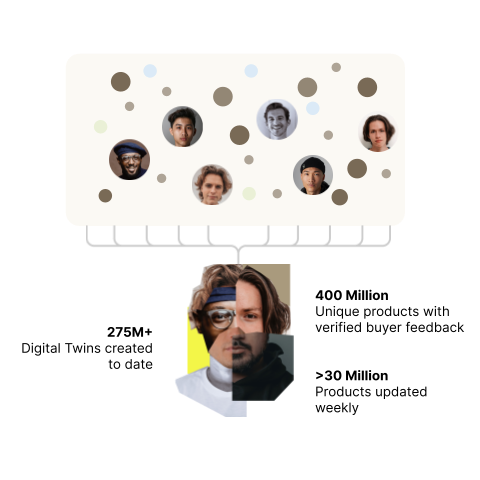Natural Language Processing AI
AI-powered customer feedback so you can take action now
Native AI turns insight into impact
Introducing Native AI, the always-on market intelligence platform that helps you understand, innovate, and create ideal experiences for your customers.

A better way to find the answers you need
Create impact through measurable improvements to products, customer experience, and marketing.
-
Analyze millions of qualitative and quantitative data points
-
Automate product and keyword tracking across the web
- Converse with digital clones of your customers in real-time
Insights Dashboard
Customize and export reports with full choice of visualizations. Set up alerts for specific products and keywords, and monitor trends over time in order to predict future consumer behaviors and identify white-space opportunities.


Bring Your Own Data
Upload your first party data in any structured or unstructured format. Our platform is compliant with international data processing regulations to eliminate unnecessary risk.
Digital Twins
Converse with digital clones of your customers or your competitors' customers. Filter by demographic, purchase channel, behavior, and more. Create visualizations and export your results.

Expert White-Glove Service
Our platform is designed for you to be successful independently, but we're here to make sure you’re able to take full advantage of the value Native AI provides.
The Native AI Difference
We're not like other all-in-one insights platforms. Get a peek under the hood.
Data Safety & Privacy
Advanced Orchestration
Synthetic Output Controls
What Is Natural Language Processing AI
Natural Language Processing (NLP) is a subfield of artificial intelligence (AI). It merges computer science, linguistics, and machine learning to allow computers to comprehend, interpret, and respond to human language in a natural and efficient way. NLP is critical in today's fast-paced, technologically evolving world as it allows AI and machine learning algorithms to understand and interact with human language.
"How does natural language processing work?” In essence, NLP involves a series of steps, starting with input from the user, typically in the form of text or speech. This is followed by lexical analysis, syntax analysis, semantic analysis, and pragmatic analysis, each presenting its own level of complexity. Through these steps, NLP is able to interpret context, understand intent and draw pragmatic meanings from phrases that would otherwise have only been understood by humans.
Natural language processing in AI is demonstrated in several applications, from voice-activated virtual assistants and translation services to social media monitoring and sentiment analysis. An example could be your GPS navigation system that converts your spoken instructions into a set route. Or, any voice-enabled home automation system that deciphers and executes spoken commands. In fields like healthcare and customer service, NLP simplifies the process of understanding and responding to natural language data, thus streamlining operations and optimizing user experiences.
NLP machine learning projects encompass various applications of machine learning and natural language processing, from sentiment analysis to topic modeling and text classification. It offers hands-on experience and a deeper understanding of how NLP works in AI. Python, with its easy-to-understand syntax and robust libraries such as NLTK and spaCy, is a preferred language for NLP and machine learning projects. It makes implementing and optimizing ML algorithms simpler, which is crucial for complex NLP tasks.
In order to code NLP, one first has to define what is ‘natural language.’ It is a language that has evolved naturally over time among humans. It's uncoded, unstructured, and follows no rigidly fixed set of rules - a stark contrast to the machine languages we use to communicate with computers. Herein lies the challenge for 'natural language processing,' which involves teaching machines to understand and interact with this free-flowing, rule-defying natural language. However, with NLP applications becoming more refined, that challenge is being met with increasing success. It underscores the transforming power and boundless potential of NLP, along with its exponential growth in the world of AI and machine learning.
Natural Language Processing Examples
Given the prevalence of Natural Language Processing (NLP) in today's Artificial Intelligence (AI) realms, let's explore some NLP examples in real life, showcasing how this technology is revolutionizing various industry sectors. NLP, an AI component, is a technique of converting human language into formats that machines can understand. Its applications range from email spam detection - an exceptional AI content detector, up to text analysis and recommendation systems.
NLP's features create a unique impact across varied domains. For instance, consider an AI system leveraged in healthcare for understanding patient queries. It must understand the features of natural language processing, such as context, semantics, and grammar, to provide adept responses. Another example would be an AI content detector, programmed to identify inappropriate content within a given context. This tool can be monumentally beneficial for parental control or content monitoring in various online platforms.
Furthermore, to understand the core functioning of this technology, examining natural language processing example projects could be very helpful. For a researcher or developer, these projects can shed light on multiple NLP facets, featuring the practicalities of this technology. Plenty of open-source repositories offer tutorials in multiple languages. A good starting point could be to look up Python natural language processing examples and sample Python code.
In nutshell, NLP spans a broad spectrum in AI, creating an overlap with practically every aspect of everyday life. The diverse examples of natural language recited above verify it. Whether it's email filtering, search optimization, or even language translators, it's indeed hard to ignore this ever-evolving AI component's significant impact.
How Native AI Uses Natural Language Processing
Native AI uses NLP to synthesize and extrapolate insights from open-text inputs such as customer reviews and market research surveys. To learn more about how our NLP technology can help you with customer and competitive intelligence, visit our solutions page.
